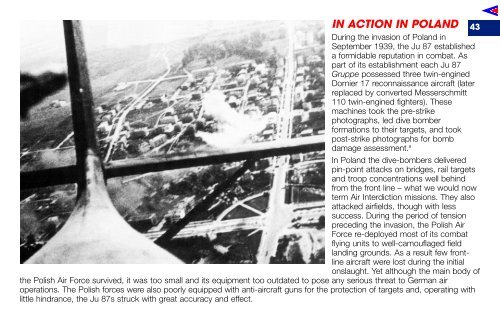THE ROYAL AIR FORCE - Air Power Studies
THE ROYAL AIR FORCE - Air Power Studies
THE ROYAL AIR FORCE - Air Power Studies
Create successful ePaper yourself
Turn your PDF publications into a flip-book with our unique Google optimized e-Paper software.
IN ACTION IN POLAND<br />
During the invasion of Poland in<br />
September 1939, the Ju 87 established<br />
a formidable reputation in combat. As<br />
part of its establishment each Ju 87<br />
Gruppe possessed three twin-engined<br />
Dornier 17 reconnaissance aircraft (later<br />
replaced by converted Messerschmitt<br />
110 twin-engined fighters). These<br />
machines took the pre-strike<br />
photographs, led dive bomber<br />
formations to their targets, and took<br />
post-strike photographs for bomb<br />
damage assessment. 8<br />
In Poland the dive-bombers delivered<br />
pin-point attacks on bridges, rail targets<br />
and troop concentrations well behind<br />
from the front line – what we would now<br />
term <strong>Air</strong> Interdiction missions. They also<br />
attacked airfields, though with less<br />
success. During the period of tension<br />
preceding the invasion, the Polish <strong>Air</strong><br />
Force re-deployed most of its combat<br />
flying units to well-camouflaged field<br />
landing grounds. As a result few frontline<br />
aircraft were lost during the initial<br />
onslaught. Yet although the main body of<br />
the Polish <strong>Air</strong> Force survived, it was too small and its equipment too outdated to pose any serious threat to German air<br />
operations. The Polish forces were also poorly equipped with anti-aircraft guns for the protection of targets and, operating with<br />
little hindrance, the Ju 87s struck with great accuracy and effect.<br />
43

















